Content
- 1 The risk of over-pollination
- 2 Why should you separate varieties?
- 3 Distance between bushes
- 4 Strawberry breeding methods
- 5 Getting seedlings from seeds
- 6 Strawberry planting site
- 7 What happens when different varieties of strawberries are planted side by side
- 8 Harvest varieties of strawberries: video
- 9 Reproduction
- 10 Selection and preparation of soil
- 11 Preparation for wintering
- 12 Features of the neighborhood of conventional and remontant varieties
- 13 conclusions
- 14 Video about why regular strawberries are better than remontant ones
Strawberries grow in almost every summer cottage. Gardeners know that it requires careful maintenance to get a good harvest. One of the questions about which controversy often arises is whether it is possible to plant strawberries of different varieties nearby. The answer to it will be presented in today's article.
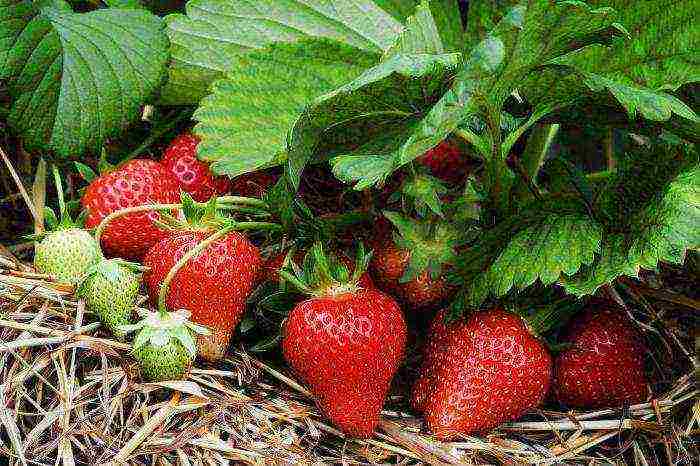
The risk of over-pollination
Many summer residents believe that different varieties of garden strawberries should be located in different places, they should not be planted next to them. Such advice is sometimes given by the sellers themselves. It is the mixing of varieties and subsequent cross-pollination that is called the reason for the low yield and small berries.
In fact, this is nothing more than a myth. Pollination is double fertilization, as a result of which the seeds receive both maternal and paternal qualities. This will definitely affect the quality of the crop.
The strawberry is a plant that has no real fruit. The berry used for food is an overgrown receptacle with exclusively maternal properties. It does not depend on which pollen was involved in the pollination process. Therefore, different varieties of strawberries in the same garden cannot affect the quality of the crop.
Why should you separate varieties?
Recommendations for planting different varieties of garden strawberries separately from each other are related to the fact that a person may subsequently become entangled in them. One of the methods of propagation of this culture is to use daughter rosettes formed from the mother plant. Since each bush gives a lot of whiskers that can become planting material, so as not to confuse varieties, it is recommended to separate them. Can I plant different varieties of strawberries nearby? Yes, but to reproduce only the species you like, you should group them. Can also be planted in separate rows or spread over different beds.
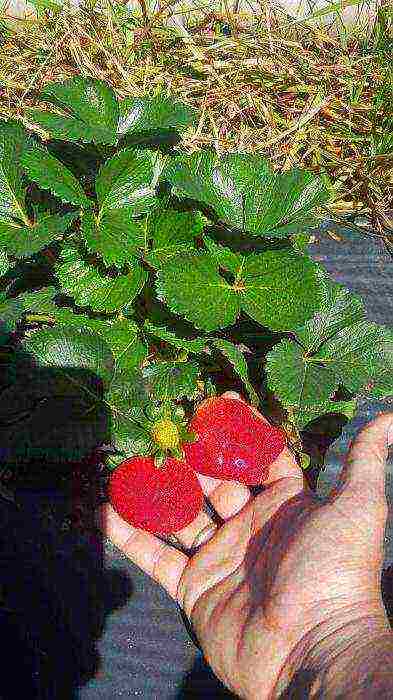
Distance between bushes
Having decided to settle garden strawberries on their site, summer residents often ask themselves a question related to the optimal distance between the bushes.
There are several methods for placing outlets on the territory. The distance between the strawberries when planting depends on the chosen method.
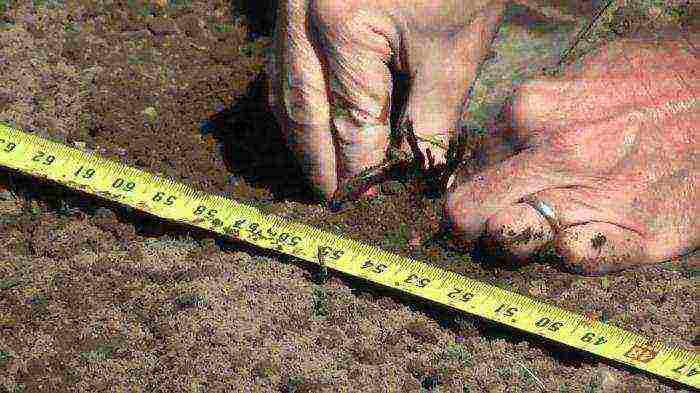
Individual bushes are located at a distance of about half a meter from each other. Most often, strawberries are planted in rows. This method is the most convenient and gives a high-quality harvest. The distance between the bushes should be about 25 cm, and between the rows - up to 60 cm. The easiest way is to plant a "carpet". The dense placement of the rosettes protects against weeds, but requires careful whisker treatment. Otherwise, the strawberry will spread far beyond the habitat.
Another option for placing garden strawberries on the site is planting nests. The meaning of this method lies in the location of one bush in the middle, and 5-6 are planted around it. The distance between strawberries when planting nests is about 7 cm.At the same time, about 30 cm should be left between the nests themselves.
Strawberry breeding methods
To plant strawberries on the site, you will need planting material.You can buy it as a seedling, grow it yourself from seeds, or use the whiskers of existing plants.
Many people know the rules for planting strawberries in spring. Seedlings need to be hardened by placing them in a cool place for a while. It is important to pay attention to the root system. It should be well developed and always with soil on the roots. Before planting, you need to prepare the soil and dig holes. The rules for planting strawberries in spring and autumn are the same. It is important that the roots in the fossa are vertical. Holding the bush with one hand, you need to fill in the roots with the other, not forgetting to tamp the ground.
Reproduction of garden berries with a mustache has its own subtleties. To get strong planting material from a bush, it is necessary to remove flowers from it, preventing the appearance of berries. In this case, all food will be given to the mustache. When they appear, you need to leave the strongest, and eliminate the rest. After the roots appear, the plants must be dug into the ground or immediately into a pot. At the end of July, the daughter bush can be separated from the mother and planted in the garden.
Getting seedlings from seeds
Growing strawberries from seeds is the most difficult way to get seedlings.
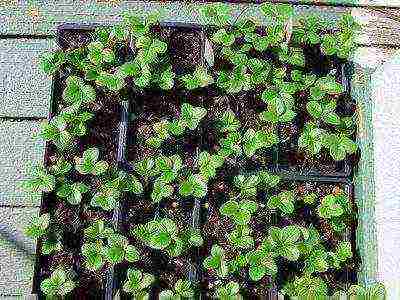
The sowing time must be observed. This is done in late February or early March. The soil should be light and fertile. Baking powder should be added to it. Can I plant different varieties of strawberries nearby? It is possible, but it is better to separate the seeds and place them in different places. This will allow you not to get confused in the future and evaluate the most successful options. If you germinate the seeds in advance, you can immediately select weak specimens. They are also recommended to be hardened by placing them in a place with a temperature slightly above zero. Strawberries love the sight, so they need to be watered constantly. Adequate lighting must be ensured. Germination can take anywhere from two to seven weeks.
Planting strawberries in open ground with seeds is possible in spring. In the fall, it is necessary to transfer the grown plants to their permanent place.
Strawberry planting site
In order for the bushes to bring a good harvest, black soil with the addition of ash is considered the optimal soil for them. For strawberries to winter well, the bushes must hold snow perfectly. For this purpose, some use spruce branches as an additional covering material.
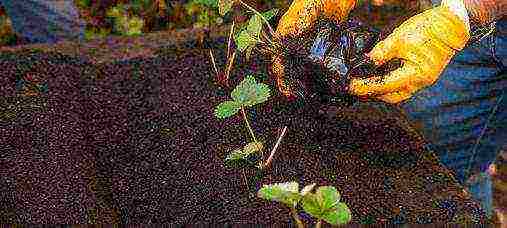
Is it possible to plant strawberries of different varieties next to each other, how can this affect the size of the crop? Some gardeners note that the berries on some bushes are getting smaller. They blame the location of several varieties in one place for this. Small berries appear for other reasons. Most often, a poor-quality crop appears due to the impoverishment of the soil and the degeneration of the variety. Therefore, it is recommended to transplant strawberries to a new place every 5 years. It is also necessary to replace varieties, especially if the bushes are affected by pests.
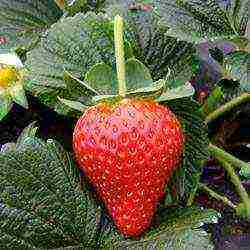 Gleb
Gleb
Can you plant different varieties of strawberries next to each other?
The end of summer and the beginning of autumn is the time to plant strawberries. If you are going to plant this crop for the first time, it is possible that you will come up with an idea to place several varieties next to each other in the garden. There are disputes among experts - is it possible to do this, whether this method of planting will harm the plant.
What happens when different varieties of strawberries are planted side by side
There is an opinion among gardeners that if you plant different strawberries together, you will get a mixture of varieties or even a degeneration of culture. Blame for this is such a property as cross-pollination. Indeed, neighboring plants will pollinate the same insects. However, any breeder will reassure you with a confident argument:
- What many call a strawberry berry is actually an overgrown receptacle of the plant. It will have the characteristics of a mother plant, regardless of mixing with the pollen of a neighboring flower during fertilization.
- The principle is also relevant in relation to daughter sockets and mustache.
- Seeds are blotches on the receptacle.They will depend on the composition of the pollen, but this will not affect the taste and appearance of strawberries.
Attention! Strawberry is a self-pollinating plant. It can successfully produce berries when planted with one species. However, it has been proven that with the proximity of two certain varieties and their cross-pollination, the yield and quality of the fruits are improved.
If you propagate strawberries with a mustache (vegetatively), then the new plants will take on the properties of the mother. But if you collect seeds from a cross-pollinated sample and plant seedlings, then the plants-children will not be a copy of the "parents". You get a mixed variety. Breeders use the effect of cross-pollination; they plant different varieties of garden strawberries nearby for crossing. This is how most modern types of garden strawberries were bred. And close-growing varieties do not affect the quality and productivity of plants planted in the garden and do not cause degeneration.

Observe agricultural practices when growing strawberries
Planting strawberries nearby: pros and cons
The reasons for planting different varieties of garden strawberries in nearby beds can be:
- desire to try different types;
- the desire to choose the best among them for further cultivation;
- small plot size.
Experienced gardeners warn that when planting several varieties of strawberries on the same bed, you need to adhere to the rules of care:
- The garden bed must be monitored and looked after. Otherwise, the plants will intertwine with rosettes and you will get confused in the varieties. Point the mustache in different directions.
- If the varieties have different ripening periods, then, accordingly, they should be watered with different intensities.
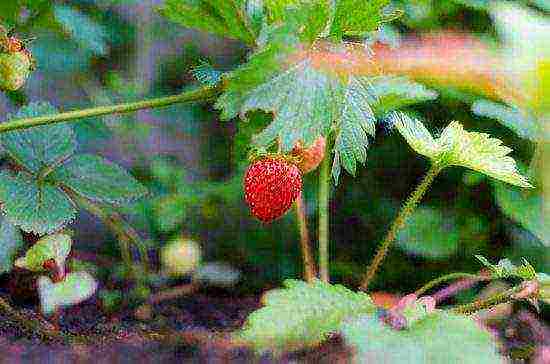
Different varieties may require different care
- Different varieties can have different heights of the bush. Low ones need mulching, which will protect them from decay.
- The garden bed will require a massive transplant.
Attention! In one place, garden strawberries grow well for only 4 years.
If you are following the garden, but the harvest has deteriorated with the new season, the reason for this may be:
- With varietal seedlings, you brought to the site a strawberry weed variety Bakhmutka, Zhmurka, Podveska, Dubnyak. They may look like strawberries but do not bear fruit.
- The seeds of the over-pollinated species fell to the ground and accidentally sprouted. In this case, varietals could, for example, die from frost. Such randomly crossed varieties are very tenacious and fertile: they will grow, but the berries will be bad.
- The earth is depleted, the plants are old.
It is possible and even useful to plant different varieties of strawberries together, but you should strictly adhere to agricultural technology and carefully look after the garden.
Harvest varieties of strawberries: video
Quite often you can hear a similar question from gardeners. To answer this, as fully as possible, you should first understand the features of the agricultural technology of any strawberry. Naturally a specific variety requires an individual approach, but these are the particulars that are used in a particular case. They depend on the characteristics and requirements of a particular type.
Reproduction
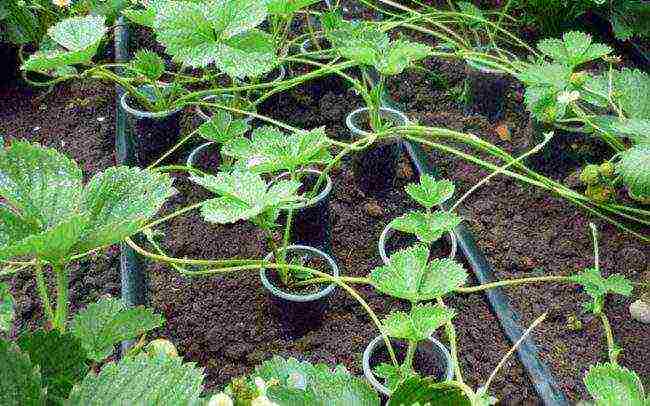
Rooting a whisker is the main way to breed strawberries in your area.
In most cases, strawberries multiply by growing and subsequent transplanting stepchildren. A week after planting, new seedlings are already capable of giving additional roots, grasping the ground firmly. Repaired varieties can be propagated by sowing seeds, however, this method is usually used in large agricultural firms, on farms, as it is a rather lengthy and troublesome method.
Dividing the bush
But the method of dividing from a bush is also used. To do this, you should choose powerful healthy bushes, find the conditional border for dividing the lateral roots, divide.
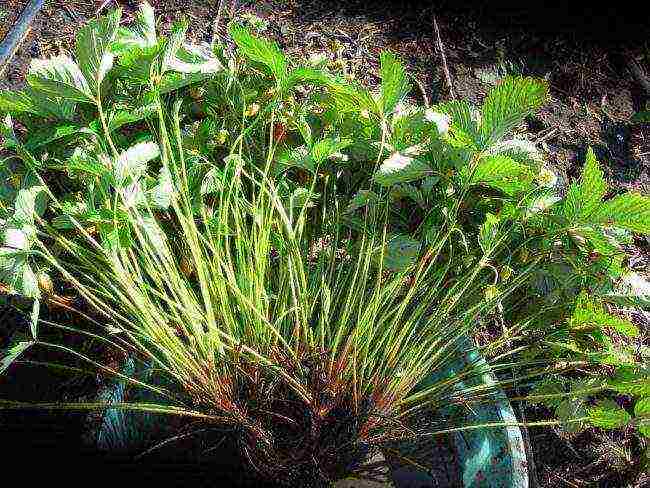
The bush chosen for dividing is dug up and its roots are washed.
It is necessary to carefully monitor thatso as not to violate the integrity of the solid root.If this happens, the plant can be thrown away, since the damaged rhizome will not be able to adapt and will die.

Each section should have its own root.
The seating scheme for regular and remontant strawberries is similar - compact bushes are planted at a distance of at least twenty centimeters, larger bushes - at a distance of forty or more centimeters.
Landing dates
Planting time - spring, late summer, mid-autumn.
- The seeds are sown in a container in February, and the seedlings are planted in open ground, as with the usual methods - spring, summer, autumn.
- It is noteworthy that biennial plants are considered the best bushes for planting.
- On the new seedlings, stepchildren are cut off so that the mother bush does not waste energy on feeding the lateral branches, but strengthens the root system, then the plant will adapt faster and enter into active development.
Selection and preparation of soil
It is characteristic that a certain type of soil is needed for each specific variety.
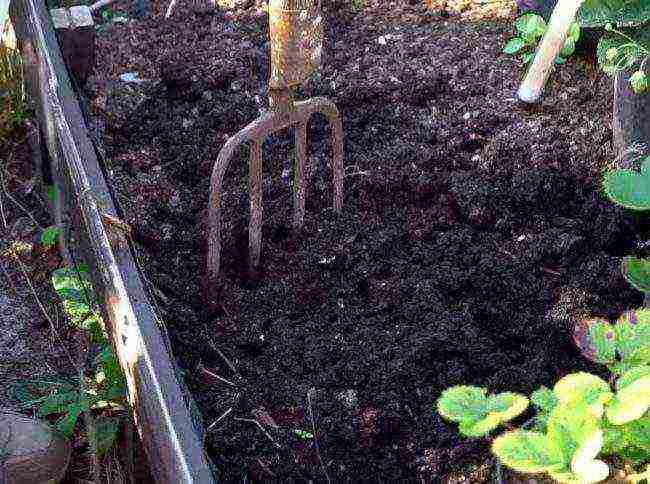
The planting mixture for each type of strawberry will have to be prepared taking into account individual needs.
One loves sandstones, another - black soil... In addition, there are plants that thrive better in mountainous terrain, or in areas located on slopes. There are hybrids for which a shaded area of the garden would be an ideal option, due to its special sensitivity to direct sunlight. General requirements for all types of strawberries:
- disinfection of land from possible pests;
- weed control;
- fertilization and feeding;
- digging;
- loosening;
- moisturizing.
After the most convenient place for planting has been chosen, the site should be decontaminated from possible soil pests - the larva of the May beetle, cabbage. Disinfection is required for greater resistance to disease.
Fertilizers
Among other things, a number of fertilizers are applied for plant nutrition.
- Mostly organic fertilizing is used - an aqueous solution of humus, peat, chicken droppings, urea.
- And compost is also made from leaves, peat and manure.
- It is allowed to use ready-made preparations purchased in gardening stores.
- Prepare top dressing strictly according to the instructions on the package.
- The characteristics of the type and variety of the plant should be taken into account.
- If early varieties of strawberries are planted, less fertilizer is used, and if plants are of medium and late ripening, a smaller amount is used.
Mulching
To create more favorable conditions, it is recommended to mulch the garden bed.
For these purposes, it is applied wheat or rye straw, pine needles, sawdust... You can cover the soil under the bushes with black agrofibre. Such measures help to prevent weed growth, retain moisture in dry weather.
As well as limit the contact of berries and leaves with the soil, which is a preventive measure against gray mold, keeps fruits clean, prevents rotting in rainy weather.
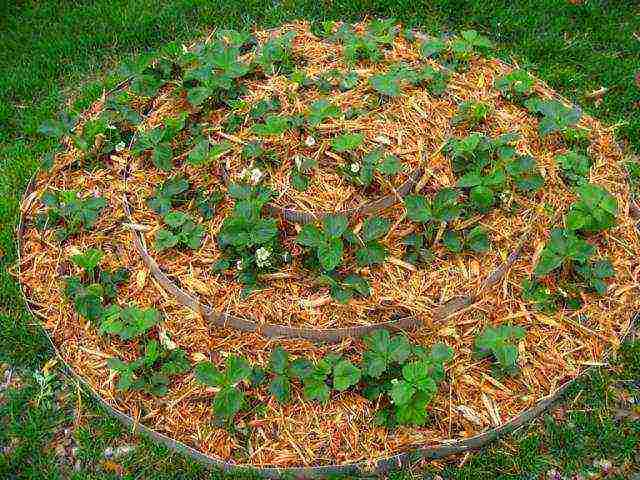
Strawberries of any variety respond well to mulching.
Preparation for wintering
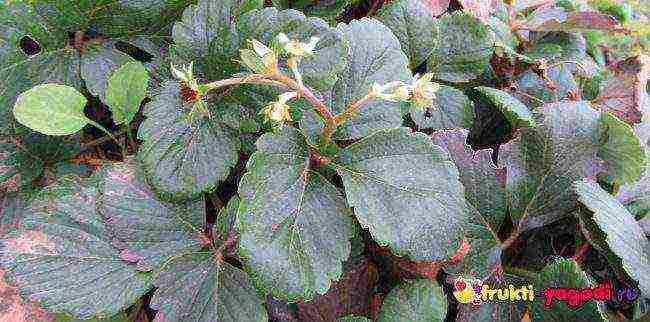
Repaired strawberries will bear fruit even in late autumn.
The differences in the training of remontants and non-remandants are slightly different.
The fact is that ordinary strawberries, as a rule, are highly resistant to frost, while remontants in most cases do not have this feature. Therefore, in preparation for wintering, for ordinary crops, you can limit yourself to a small layer of mulch or thin agrofibre on the arcs. Many varieties do not need to be covered at all for the winter.
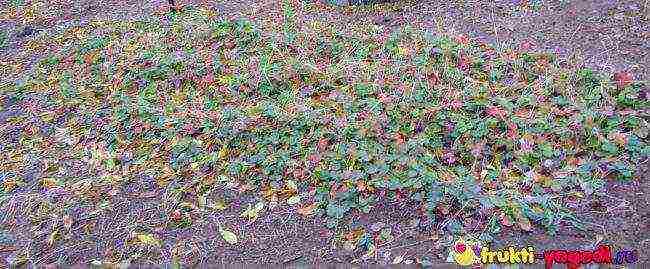
Ordinary strawberry bushes do not need a lot of cover.
Repairers - the vast majority - need a tight cover. The bed is covered with a thick layer of mulch, a strong frame or arc structure is built, and covered with roofing material or dense agrofibre.You can cover with dry leaves instead of straw or sawdust. During the winter, both the mulch and the leaves will rot, a kind of additional fertilizer is formed.

Most remontant strawberries require shelter for the winter.
In addition, there are types of culture for which a southern climate is preferable, and in the northern regions or in the middle lane, the plant reacts to the slightest cold snap. In this case, cultivation is recommended only in closed ground - greenhouses or hotbeds.
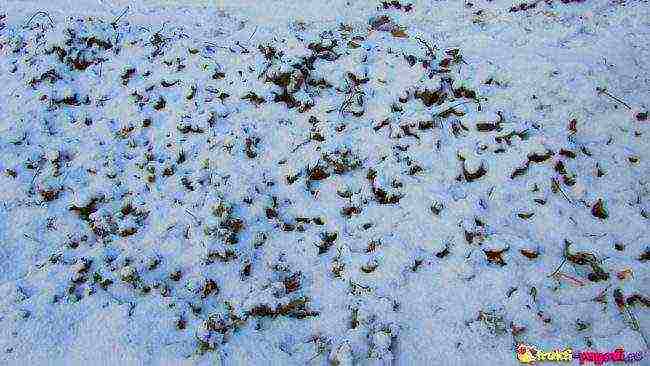
This patch of strawberries survived the cold winter even without shelter!
Features of the neighborhood of conventional and remontant varieties
There are some types of strawberries that are unable to pollinate on their own.
In order for pollination to occur, a similar variety is planted next to it, but already capable of self-reproduction. As for the distance, then, as a rule, the beds are delimited by other crops.
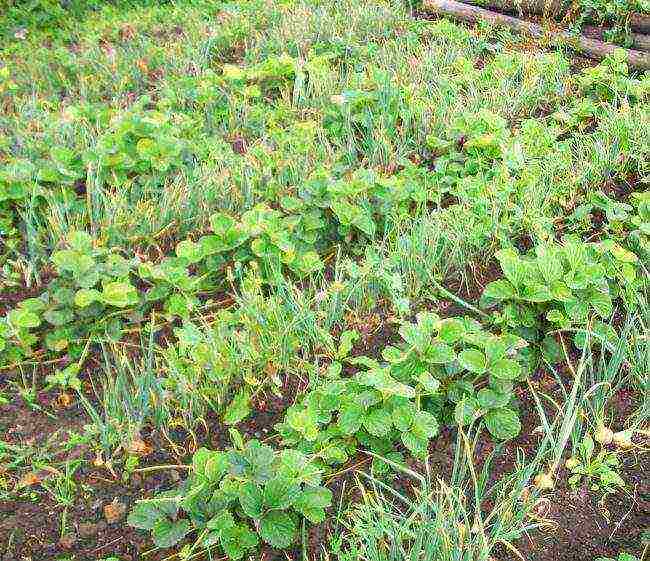
On this site, the owners divided the two varieties of strawberries into a bed of onions.
It is allowed to plant cabbage, onions, garlic, bell peppers on the border of different types... Most often, gardeners use garlic to delimit. It is not recommended to plant strawberries near a potato field. But it is also worth refraining from planting hot peppers in the neighborhood. It is necessary to avoid the neighborhood with tall and dense garden crops, as a shadow will constantly fall on the strawberry beds, and this slows down growth and reproduction, affects the size and taste of the berries.
conclusions
Neighborhood of different species - remontant and ordinary ones in no way affects any of the species.
Influence and degeneration can occur only in one case - when planting seeds. If the seeds were sown, and for some reason the seeds of the two varieties got mixed up, and the sprouted seedlings were planted as one species. In all other cases, the plants are not threatened.
Video about why regular strawberries are better than remontant ones
Hello! Is it possible to plant different varieties of strawberries nearby in a small area? Margarita Semyonovna.
Disputes on the topic of whether it is possible to plant different varieties of strawberries next to each other, or still, they should be planted in areas distant from each other, do not subside among gardeners. This article will help you understand how nearby varieties planted affect each other and what can increase the yield of strawberries.
Yes or no joint planting of different varieties of strawberries
According to biological laws, nearby strawberry varieties do not affect each other in any way, since the berries obtained are the carrier of only the varietal characteristics of the parent plant and are not the result of over-pollination of neighboring varieties. In view of this, planting different varieties of strawberries in the same area is quite acceptable. And yet, as the experience of strawberry cultivation shows, there is one argument that convinces of the need for, if not remote, then at least separated plantings.
Different varieties of strawberries will not interfere with each other in the same area
Attention! When growing different varieties in neighboring beds, you should monitor that the growing mustache layers take root only in their own bed, without climbing the next one. Otherwise, after 1-2 years it will be difficult to distinguish where which variety is planted - they will simply mix with each other.
You can avoid mixing if you plant several beds of garlic between adjacent varieties. And if the area allotted for strawberries is very small and there is simply nowhere to plant other crops, pieces of slate will come to the rescue, which must be dug in between neighboring varieties, forming a fence 30-40 cm high.
The need for separate plantings is also caused by different periods of fruiting and care requirements at different stages of the growing season. Harvesting and caring for separately planted varieties is much easier.
So that the varieties do not get confused with each other, you can plant garlic between them
It should be noted that some varieties of strawberries, even when planted separately, begin to shrink over time. This process is natural and associated with the biological characteristic of the variety. In this situation, you just need to regularly update the variety or replace it with another, more stable one. In addition, the quality of the soil and the observance of agrotechnical conditions have a great influence on the size of berries and their yield.
Tips for good harvests
By adopting a few simple recommendations, you can achieve an increase in strawberry yield:
1. Thinning. Please note that most varieties reduce yields precisely because of the thickening of the plantings. Thinning increases the area of nutrition and the amount of nutrients obtained from the remaining bushes, respectively, the level of their fruiting increases.
Attention! Removing unnecessary mustache layering also has a positive effect on strawberry yields.
2. Good lighting. Planting strawberries in the shade of bushes and trees negatively affects yields. The more sunlight the strawberry bush gets, the more berries it will collect.
To keep yields high, varieties need to be renewed periodically.
3. Low beds. When growing strawberries in high beds, plants often suffer from drying out in summer and freezing in winter. The only exception is the presence of stagnant water in the ground, in which case high beds are the only salvation.
Advice! For mulching strawberry plantings, you can use compost, straw, needles, mowed chopped grass, sawdust, peat.
4. Mulching with organic materials. This simple agrotechnical application will not only save time and effort, but also protect the root system of plants from damage during weeding.
5. Introduction of dressings. Regular feeding helps to increase the yield of strawberries. The main thing is not to overdo it, because with an excess of nitrogen in the soil, the bushes will be powerful and leafy, and there will be few berries.
Strawberries of all varieties need regular feeding
6. After the end of fruiting, strawberry bushes do not cease to need care, because at this time the laying of the future harvest is taking place. Do not forget to remove weeds, water and feed the strawberry plantings until the beginning of autumn.
Regardless of the number of strawberry varieties in your area and their close planting to each other, obtaining consistently high yields depends only on the quality of agricultural technology.
Feeding strawberries in spring - video


